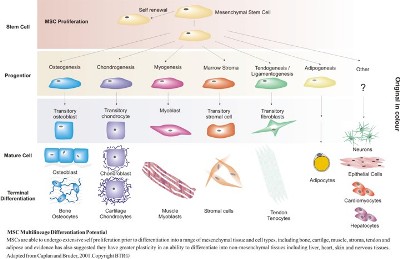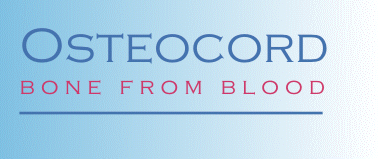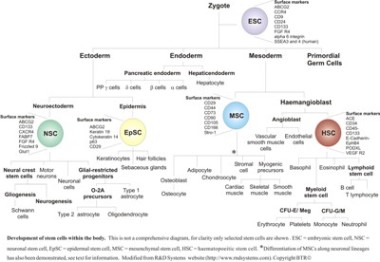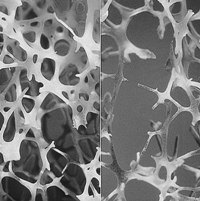A European Union 6th Framework funded project with €2.5 million funding over 3 years |
Osteogenesis
Bone and cartilage are specialised connective tissues that together form the skeletal system (bone structure). The structural integrity of the skeleton is maintained by coordinated actions of a number of cells primarily involving osteoblasts and osteoclasts. Bone is a dynamic tissue and throughout our lives, it continually undergoes a cycle of degradation and reformation. The continuous removal of bone, also termed resorption, arises from the actions of osteoclasts. Osteoblasts are responsible for the synthesis of new bone and subsequent mineralisation in a process called bone remodelling.
Once fully matured, osteoblasts line the sites of active bone formation, so if we are attempting to create new bone cells in vitro we need to find a source of osteoblasts. The process of creating bone is osteogenesis.
Sources of osteoblasts
Osteoblasts can be derived from pluripotent embryonic stem cells (ESCs) and undifferentiated multipotent mesenchymal stem cells (MSCs). MSCs, or progenitor cells, are present in adult tissues including bone marrow (BM-MSCs) and liver, foetal tissues, amniotic fluid and umbilical cord blood (CB-MSCs).
Differentiation Capacity of ESCs
Embryonic stem cells (ESCs) have the capacity to differentiate to become nearly every type of cell in the body and are widely regarded as the 'gold standard' stem cell against which potential of all others are measured.
click on the image to view larger version which you can save in jpg format
Differentiation Capacity of MSCs
Evidence shows that the differentiation capacity of mesenchymal stem cells is not only limited to osteoblasts but extends to a variety of cell types such as chondrocytes, adipocytes (fat), cardiomyocytes (heart muscle) and neuronal (nerve) cells. MSCs also give rise to the connective tissue framework (stromal environment) that supports hematopoiesis by providing the extracellular matrix components, such as cytokines and growth factors.
Typically, the in vitro differentiation of MSCs to osteoblasts involves incubation of a confluent monolayer of MSCs in osteogenic medium (50 µg/mL L-ascorbic acid phosphate, 5mM-glycerophosphate and 10 nM dexamethasone) for 2-3 weeks. The osteogenic induction is evaluated by alkaline phosphatase activity, staining for mineralisation and the expression of osteoblast markers.
 click on the image to view larger version which you can save in jpg format
click on the image to view larger version which you can save in jpg format
In order to work with MSCs they need to be extracted from their source. The OsteoCord project is primarily concerned with MSCs derived from bone marrow (BM-MSCs) and umbilical cord blood (CB-MSCs).
Read more about the extraction and isolation of MSCs here.


